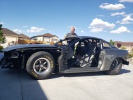I'm using a gen 3 5.3 basic standalone harness what I'm my questions are
1. Would it be safe to run open loop considering the boat is only used during the summer months?
2. How terrible would fuel efficiency be granted it has no trans just a single speed so I dont expect to be 20+mpg anyways.
3. Is there any benefit to retaining the Maf and not keeping the o2s?
The issue i have with keeping the o2 sensors is the exhaust is water cooled and so it is a pita to install them anywhere in the exhaust as even at the exit the water then mixes with the exhaust gas and leaves the boat, the other option I explored was to drill the cast manifolds and install them but I had a very poor success rate with that and also they would be very close to the heads which I have been told is no good on the o2 sensors. the motor is all stock no plans for modding it as my out drive will not support anymore power as it is. As far as tuning I have the ability to run a wide band temporarily with the first set of exhaust I tried to make ever they are cracked so it would only be a temp install to get wide band readings. I'm looking for any advice on what the best solution to this is? Also I am a tuning rookie so I've been reading on various different ways to tune maybe even the stock tune would be fine i have no idea.




 Reply With Quote
Reply With Quote

